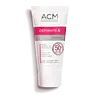What's inside
What's inside
 Key Ingredients
Key Ingredients

 Benefits
Benefits

 Concerns
Concerns

 Ingredients Side-by-side
Ingredients Side-by-side

Water
Skin ConditioningTitanium Dioxide
Cosmetic ColorantIsodecyl Neopentanoate
EmollientTriethylhexanoin
MaskingC12-15 Alkyl Benzoate
AntimicrobialGlycerin
HumectantCyclopentasiloxane
EmollientPolyglyceryl-4 Isostearate
EmulsifyingCetyl PEG/PPG-10/1 Dimethicone
EmulsifyingHexyl Laurate
EmollientAlumina
AbrasiveC30-45 Alkyl Methicone
EmollientC30-45 Olefin
Skin ConditioningCyclohexasiloxane
EmollientStearic Acid
CleansingCaprylic/Capric Triglyceride
MaskingCaprylyl Glycol
EmollientDisodium EDTA
CI 77492
Cosmetic ColorantOctyldodecanol
EmollientPentaerythrityl Tetra-Di-T-Butyl Hydroxyhydrocinnamate
AntioxidantSilica Dimethyl Silylate
EmollientSodium Chloride
MaskingSodium Myristoyl Glutamate
CleansingSorbic Acid
PreservativeTalc
AbrasiveCI 77891
Cosmetic ColorantTocopheryl Glucoside
EmollientTriethoxycaprylylsilane
Xanthan Gum
EmulsifyingWater, Titanium Dioxide, Isodecyl Neopentanoate, Triethylhexanoin, C12-15 Alkyl Benzoate, Glycerin, Cyclopentasiloxane, Polyglyceryl-4 Isostearate, Cetyl PEG/PPG-10/1 Dimethicone, Hexyl Laurate, Alumina, C30-45 Alkyl Methicone, C30-45 Olefin, Cyclohexasiloxane, Stearic Acid, Caprylic/Capric Triglyceride, Caprylyl Glycol, Disodium EDTA, CI 77492, Octyldodecanol, Pentaerythrityl Tetra-Di-T-Butyl Hydroxyhydrocinnamate, Silica Dimethyl Silylate, Sodium Chloride, Sodium Myristoyl Glutamate, Sorbic Acid, Talc, CI 77891, Tocopheryl Glucoside, Triethoxycaprylylsilane, Xanthan Gum
Water
Skin ConditioningGlycerin
HumectantPropanediol
SolventSqualane
EmollientAscorbyl Glucoside
AntioxidantDipropylene Glycol
HumectantNiacinamide
SmoothingButylene Glycol
HumectantPolymethylsilsesquioxane
Hdi/Trimethylol Hexyllactone Crosspolymer
Carbomer
Emulsion StabilisingSodium Hydroxide
BufferingPentylene Glycol
Skin ConditioningTocopheryl Acetate
AntioxidantC14-22 Alcohols
Emulsion Stabilising1,2-Hexanediol
Skin ConditioningCaprylyl Glycol
EmollientAmmonium Acryloyldimethyltaurate/Vp Copolymer
Salicylic Acid
MaskingSodium Citrate
BufferingLysine
Skin ConditioningAzelaic Acid
BufferingC12-20 Alkyl Glucoside
EmulsifyingDisodium Phosphate
BufferingMannitol
HumectantXylitol
HumectantAndrographis Paniculata Leaf Extract
AstringentRhamnose
HumectantSodium Metabisulfite
AntioxidantPotassium Phosphate
BufferingSaccharide Isomerate
HumectantBiosaccharide Gum-1
HumectantGlycyrrhiza Glabra Root Extract
BleachingGlyceryl Caprylate
EmollientSodium Anisate
AntimicrobialSodium Levulinate
Skin ConditioningFructooligosaccharides
HumectantCaprylic/Capric Triglyceride
MaskingHexapeptide-2
BleachingLaminaria Ochroleuca Extract
Skin ConditioningParfum
MaskingWater, Glycerin, Propanediol, Squalane, Ascorbyl Glucoside, Dipropylene Glycol, Niacinamide, Butylene Glycol, Polymethylsilsesquioxane, Hdi/Trimethylol Hexyllactone Crosspolymer, Carbomer, Sodium Hydroxide, Pentylene Glycol, Tocopheryl Acetate, C14-22 Alcohols, 1,2-Hexanediol, Caprylyl Glycol, Ammonium Acryloyldimethyltaurate/Vp Copolymer, Salicylic Acid, Sodium Citrate, Lysine, Azelaic Acid, C12-20 Alkyl Glucoside, Disodium Phosphate, Mannitol, Xylitol, Andrographis Paniculata Leaf Extract, Rhamnose, Sodium Metabisulfite, Potassium Phosphate, Saccharide Isomerate, Biosaccharide Gum-1, Glycyrrhiza Glabra Root Extract, Glyceryl Caprylate, Sodium Anisate, Sodium Levulinate, Fructooligosaccharides, Caprylic/Capric Triglyceride, Hexapeptide-2, Laminaria Ochroleuca Extract, Parfum
 Reviews
Reviews

Ingredients Explained
These ingredients are found in both products.
Ingredients higher up in an ingredient list are typically present in a larger amount.
This ingredient is an emollient, solvent, and texture enhancer. It is considered a skin-softener by helping the skin prevent moisture loss.
It helps thicken a product's formula and makes it easier to spread by dissolving clumping compounds.
Caprylic Triglyceride is made by combining glycerin with coconut oil, forming a clear liquid.
While there is an assumption Caprylic Triglyceride can clog pores due to it being derived from coconut oil, there is no research supporting this.
Learn more about Caprylic/Capric TriglycerideCaprylyl Glycol is a humectant and emollient, meaning it attracts and preserves moisture.
It is a common ingredient in many products, especially those designed to hydrate skin. The primary benefits are retaining moisture, skin softening, and promoting a healthy skin barrier.
Though Caprylyl Glycol is an alcohol derived from fatty acids, it is not the kind that can dry out skin.
This ingredient is also used as a preservative to extend the life of products. It has slight antimicrobial properties.
Learn more about Caprylyl GlycolGlycerin is already naturally found in your skin. It helps moisturize and protect your skin.
A study from 2016 found glycerin to be more effective as a humectant than AHAs and hyaluronic acid.
As a humectant, it helps the skin stay hydrated by pulling moisture to your skin. The low molecular weight of glycerin allows it to pull moisture into the deeper layers of your skin.
Hydrated skin improves your skin barrier; Your skin barrier helps protect against irritants and bacteria.
Glycerin has also been found to have antimicrobial and antiviral properties. Due to these properties, glycerin is often used in wound and burn treatments.
In cosmetics, glycerin is usually derived from plants such as soybean or palm. However, it can also be sourced from animals, such as tallow or animal fat.
This ingredient is organic, colorless, odorless, and non-toxic.
Glycerin is the name for this ingredient in American English. British English uses Glycerol/Glycerine.
Learn more about GlycerinWater. It's the most common cosmetic ingredient of all. You'll usually see it at the top of ingredient lists, meaning that it makes up the largest part of the product.
So why is it so popular? Water most often acts as a solvent - this means that it helps dissolve other ingredients into the formulation.
You'll also recognize water as that liquid we all need to stay alive. If you see this, drink a glass of water. Stay hydrated!
Learn more about Water